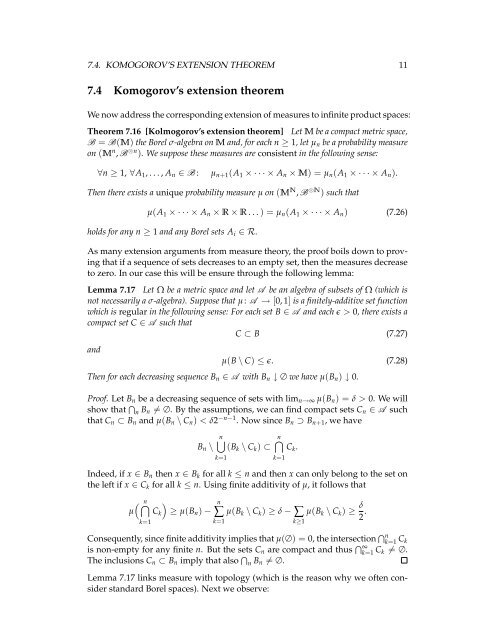You also want an ePaper? Increase the reach of your titles
YUMPU automatically turns print PDFs into web optimized ePapers that Google loves.
7.4. KOMOGOROV’S EXTENSION THEOREM 11<br />
7.4 Komogorov’s extension theorem<br />
We now address the corresponding extension of measures to infinite <strong>product</strong> <strong>spaces</strong>:<br />
Theorem 7.16 [Kolmogorov’s extension theorem] Let M be a compact metric space,<br />
B = B(M) the Borel s-algebra on M and, for each n 1, let µn be a probability measure<br />
on (M n , B ⌦n ). We suppose these measures are consistent in the following sense:<br />
8n 1, 8A1,...,An 2 B : µn+1(A1 ⇥···⇥An ⇥ M) =µn(A1 ⇥···⇥An).<br />
Then there exists a unique probability measure µ on (M N , B ⌦N ) such that<br />
µ(A1 ⇥···⇥An ⇥ R ⇥ R ...)=µn(A1 ⇥···⇥An) (7.26)<br />
holds for any n 1 and any Borel sets Ai 2R.<br />
As many extension arguments from measure theory, the proof boils down to proving<br />
that if a sequence of sets decreases to an empty set, then the measures decrease<br />
to zero. In our case this will be ensure through the following lemma:<br />
Lemma 7.17 Let W be a metric space and let A be an algebra of subsets of W (which is<br />
not necessarily a s-algebra). Suppose that µ : A ! [0, 1] is a finitely-additive set function<br />
which is regular in the following sense: For each set B 2 A and each e > 0, there exists a<br />
compact set C 2 A such that<br />
C ⇢ B (7.27)<br />
and<br />
µ(B \ C) apple e. (7.28)<br />
Then for each decreasing sequence Bn 2 A with Bn # ∆ we have µ(Bn) # 0.<br />
Proof. Let Bn be a decreasing sequence of sets with limn!• µ(Bn) =d > 0. We will<br />
show that T<br />
n Bn 6= ∆. By the assumptions, we can find compact sets Cn 2 A such<br />
that Cn ⇢ Bn and µ(Bn \ Cn) < d2 n 1 . Now since Bn Bn+1, we have<br />
Bn \<br />
n[<br />
(Bk \ Ck) ⇢<br />
k=1<br />
n\<br />
Ck. Indeed, if x 2 Bn then x 2 B k for all k apple n and then x can only belong to the set on<br />
the left if x 2 C k for all k apple n. Using finite additivity of µ, it follows that<br />
⇣ \ n<br />
µ<br />
k=1<br />
C k<br />
⌘<br />
µ(Bn)<br />
k=1<br />
n<br />
 µ(Bk \ Ck) d  µ(Bk \ Ck) k=1<br />
k 1<br />
Consequently, since finite additivity implies that µ(∆) =0, the intersection T n k=1 C k<br />
is non-empty for any finite n. But the sets Cn are compact and thus T • k=1 C k 6= ∆.<br />
The inclusions Cn ⇢ Bn imply that also T<br />
n Bn 6= ∆.<br />
Lemma 7.17 links measure with topology (which is the reason why we often consider<br />
standard Borel <strong>spaces</strong>). Next we observe:<br />
d<br />
2 .
















